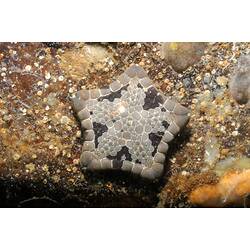General Description
Arms 5, arm rays merge with disc, pentagonal. Six large plates around the edge between arm tips. Plates on oral surface underneath near the mouth (oral plates) usually covered with granules. Usually two colours in alternating bands, as combinations of brown, black, pink, or cream markings. These bands distinguish it from the related Tosia australis which may be similarly coloured but in a star-burst pattern. Centre to arm tip up to 3 cm.
Biology
This species was recently separated from a related species, partly based on its reproductive strategy. Spawning occurs in late winter and broods of embryos are protected in depressions under the adult body.
Distribution
South-eastern Australia.
Habitat
In the open or under rocks in sub-tidal areas, to depth of 26 m.
More Information
-
Animal Type
-
Animal SubType
-
Brief Id
Arms 5, pentagonal, 6 plates along edge between arm tips, oral plates granular, usually two colours.
-
Colours
Brown, White, Black
-
Habitats
-
Diet
Carnivore
-
Diet Categories
Encrusting Invertebrates, Sponge
-
Endemicity
-
Commercial
No
-
Conservation Statuses
CITES: Not listed, FFG Threatened List: Not listed, DSE Advisory List: Not listed, IUCN Red List: Not listed
-
Depths
Shore (0-1 m), Shallow (1-30 m)
-
Water Column Locations
On or near seafloor
-
Taxon Name
-
Scientific Author
Naughton & O'Hara, 2009
-
Common Name
Biscuit Star
-
Phylum
-
Subphylum
-
Class
-
Superorder
-
Order
-
Family
-
Genus
-
Species Name
neossia





